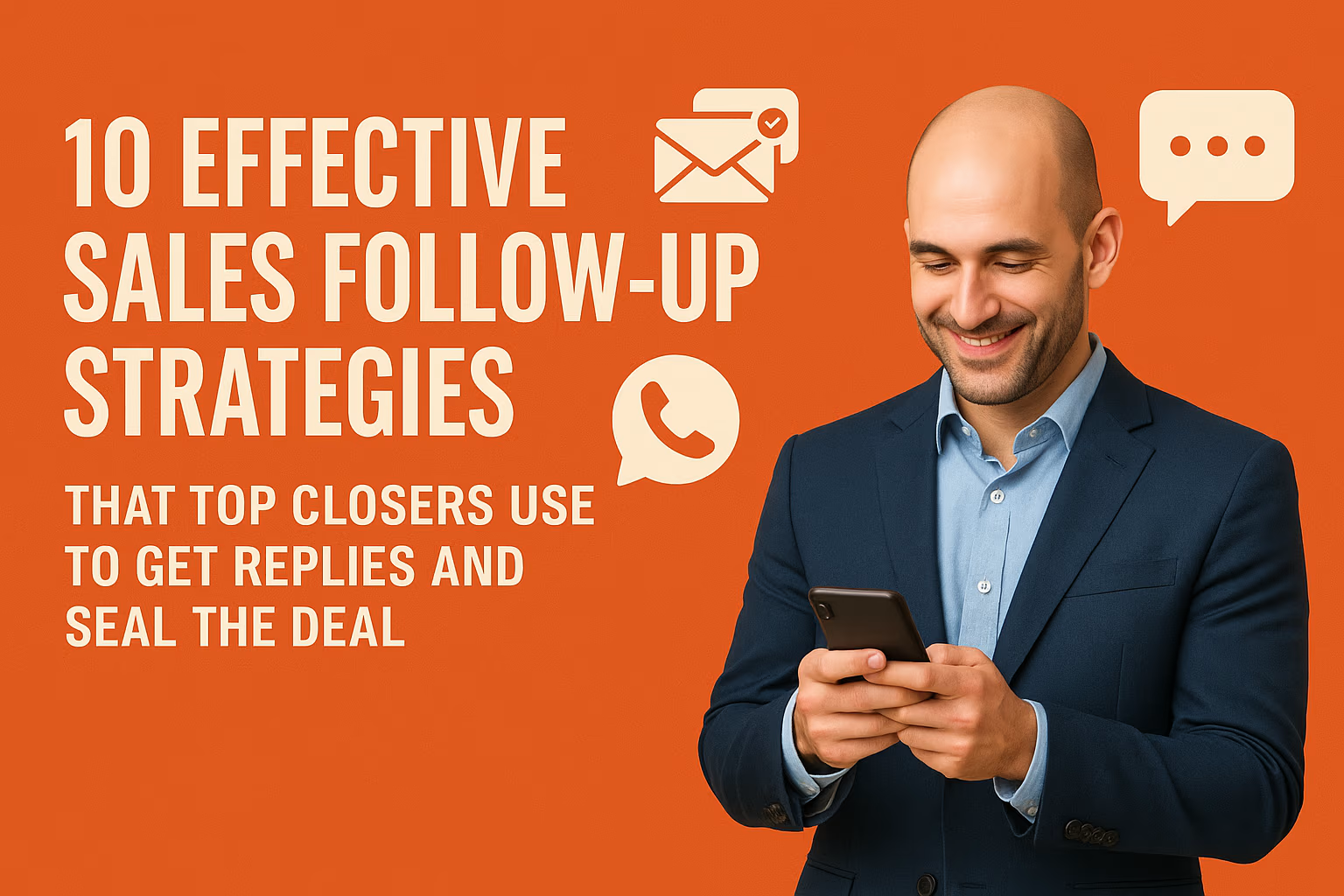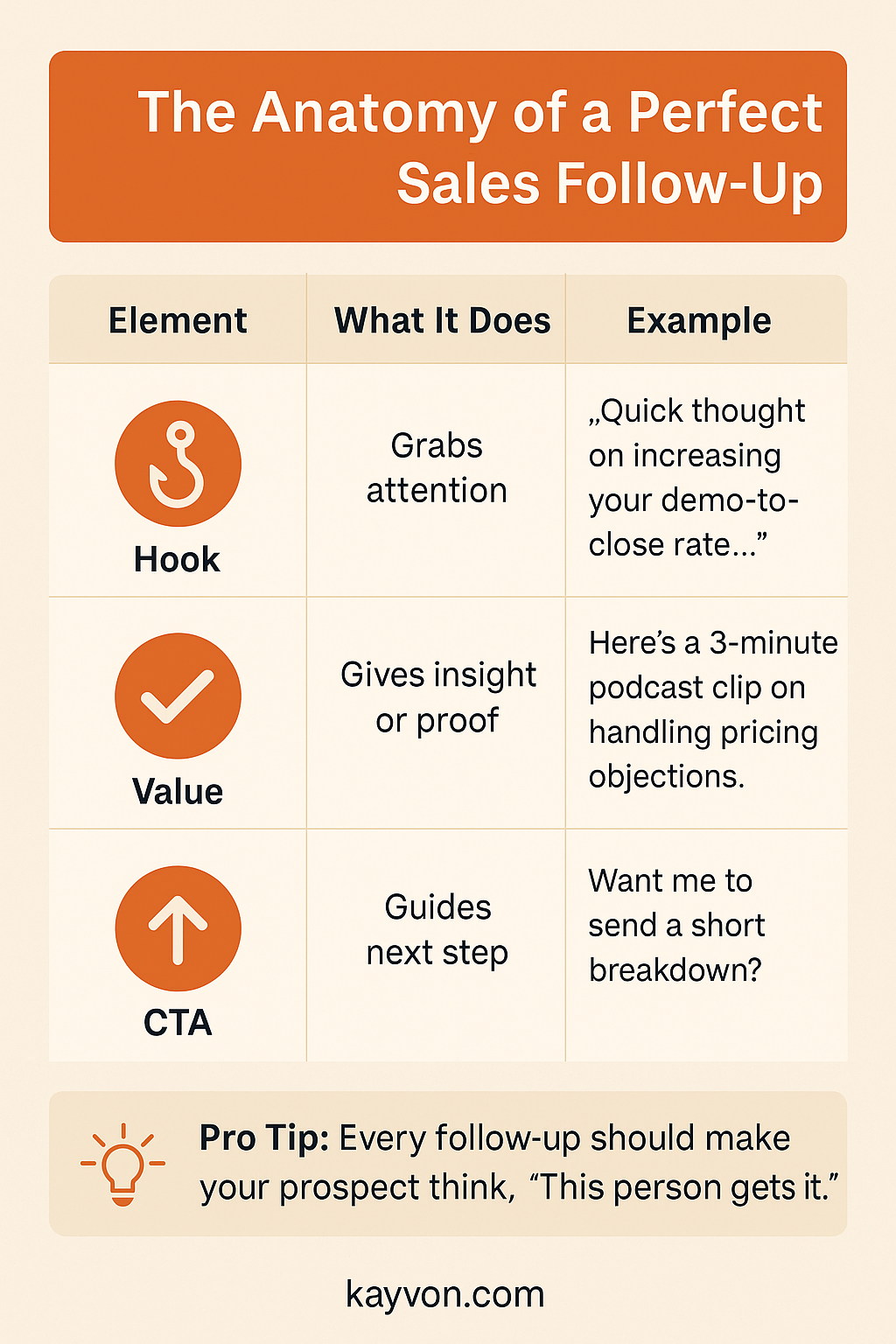
Lorem ipsum dolor sit amet, consectetur adipiscing elit. Suspendisse varius enim in eros elementum tristique. Duis cursus, mi quis viverra ornare, eros dolor interdum nulla, ut commodo diam libero vitae erat. Aenean faucibus nibh et justo cursus id rutrum lorem imperdiet. Nunc ut sem vitae risus tristique posuere.

October 13, 2025
Most deals aren’t lost because of bad pitches; they’re lost because of bad follow-ups.
If you think one email or call is enough, you’re playing in the minor leagues. The top closers who consistently win know that the fortune lies in the follow-up.
In today’s crowded inbox world, the difference between getting ignored and getting a reply comes down to your strategy, timing, and tone. You can’t just chase; you’ve got to add value, build connections, and earn trust with every touchpoint.
Let’s break down 10 follow-up strategies that high performers use to turn “not now” into “let’s talk.”
If your follow-up reads like a template, it’s already dead. Generic emails are invisible in 2025. Personalization isn’t about dropping a first name; it’s about relevance.
Reference a specific detail from your last call. Mention their business challenge. Align your follow-up with their goals. When your message feels tailor-made, your chances of a reply skyrocket.
Example:
“You mentioned you’re rolling out your Q2 expansion next month. Here’s an idea that could help your reps ramp faster before launch.”
It’s not about “checking in.” It’s about showing up with purpose.
💡Pro tip: Use CRM insights and notes from previous interactions to personalize every message. According to HubSpot, personalized follow-ups can increase response rates by over 30%.
Timing kills more deals than competition ever will. The longer you wait, the colder your lead gets.
Strike while the conversation is hot, ideally within 24 hours of your last interaction. But don’t just rush a “checking in” email. Lead with value. Reference the previous discussion and add something new, maybe a resource, stat, or insight.
Speed builds trust. Intent builds momentum.
If you’re relying on email alone, you’re invisible. Prospects live across various platforms, including email, LinkedIn, phone, SMS, and even video.
Switch it up. Start with an email, follow up with a short LinkedIn voice note or video message, and finish with a text. Multiple touchpoints increase visibility without being pushy.
A simple, confident message like:
“Great speaking with you! Here’s the quick summary of what we discussed and the next step that’ll move you closer to your goal.”
Fast, value-packed, and forward-focused. That’s how you stay top of mind without coming across as needy.
🏓Try this: Send a quick 30-second video recap of your conversation. It’s personal, it’s memorable, and it positions you as the pro who actually cares.
Every follow-up should give, not take. Don’t just ask for an update; bring value to the table.
Share a relevant article or a new market insight that speaks to their challenge. The goal? To educate and elevate, not just sell.
Every follow-up should earn attention. That means offering something helpful, an article, a podcast episode, a case study, or a quick insight.
Example:
“Thought you might find this 2-minute clip from “XYZ” podcast valuable, it dives into how top reps overcome pricing objections like the one you mentioned.”
When you follow up with your follow-up teaches, you become a trusted advisor, not another salesperson. The more value you provide, the less you feel like a salesperson and the more you become a trusted advisor.
Facts tell. Stories sell.
When following up, don’t just restate the features of your product or service; share a story about how another client solved the same problem with your solution.
Stories trigger emotions, and emotions drive decision-making. They don’t just remember your offer, they feel it.
Long follow-ups bury the point. Top closers know how to cut through noise fast.
Stick to three parts:
Example:
“You mentioned streamlining your team’s follow-up process. Here’s a 2-minute read on the tools top closers use to automate without losing the human touch. Want me to send the setup guide?”
Short, relevant, and easy to reply to.
People trust results more than promises. If your prospect’s gone silent, bring proof.
Example:
“Another client in your industry used our process and boosted conversions by 22% in 45 days. Thought you’d like to see how.”
Numbers sell. Success stories inspire. Use both.
There’s a rhythm to follow-ups. Too soon, and you look overeager. Too late, and the trail goes cold.
Top closers follow the 3-3-7 rule:
Utilize automation tools (such as HubSpot or Close CRM) to schedule and track touchpoints, but ensure that every message remains personal.
Automation should amplify your effort, not replace your humanity.
Utilize tools like HubSpot, Close, or Salesforce to schedule reminders and automate basic sequences, while keeping personalization at the forefront.
The best reps use automation for consistency, and their personality for connection.
Here’s the challenging love part: not every prospect will close, and not every follow-up will land.
If you’ve followed up multiple times without a response, step back gracefully, but leave the door open for further communication.
A powerful “breakup email” can actually reignite interest:
“Sounds like the timing might not be right now. I’ll circle back in a few months, but if priorities shift before then, here’s my direct line.”
That level of confidence shows leadership and often gets a response.
💡According to Yesware, persistence pays off; reps who send a second follow-up still have a 21% chance of getting a reply, and nearly 25% of all replies come later in the sequence.
The lesson? Keep showing up

Follow-up isn’t about chasing; it’s about leading.
Top closers don’t “check in.” They show up with purpose, value, and confidence. They understand that every follow-up is an opportunity to strengthen trust, reinforce value, and advance the deal.
If you’re ready to master the art of follow-up and transform your pipeline into predictable revenue, start with training that sharpens your skills and systems.
Want more real-world tactics? Tune into The Vault Unlocked, where we break down the psychology of follow-ups that close.
Because in sales, it’s not who follows up the most, it’s who follows up best.

Kayvon Kay
Kayvon has over two decades of experience working with high-level closers and perfecting his sales methodologies. He has earned the title of Canada’s #1 pharmaceutical sales representative and continues to share his expertise as a keynote speaker and through his multi-million-dollar coaching program.